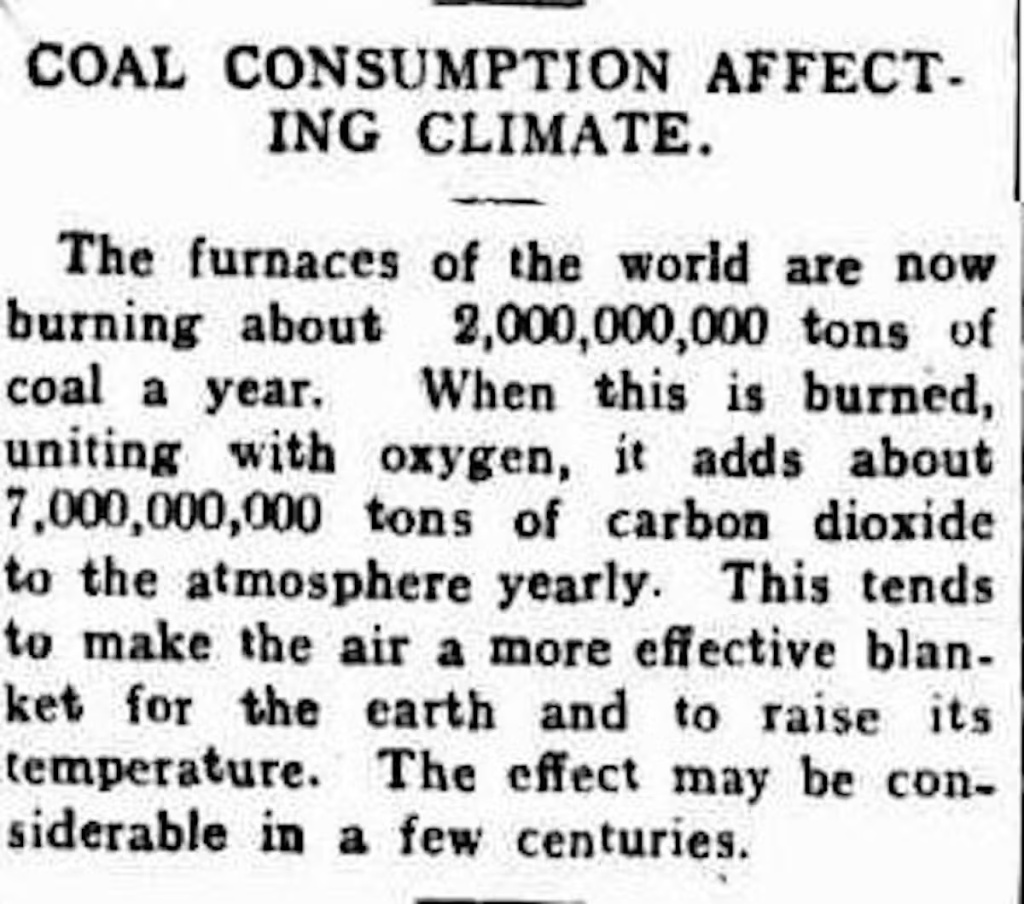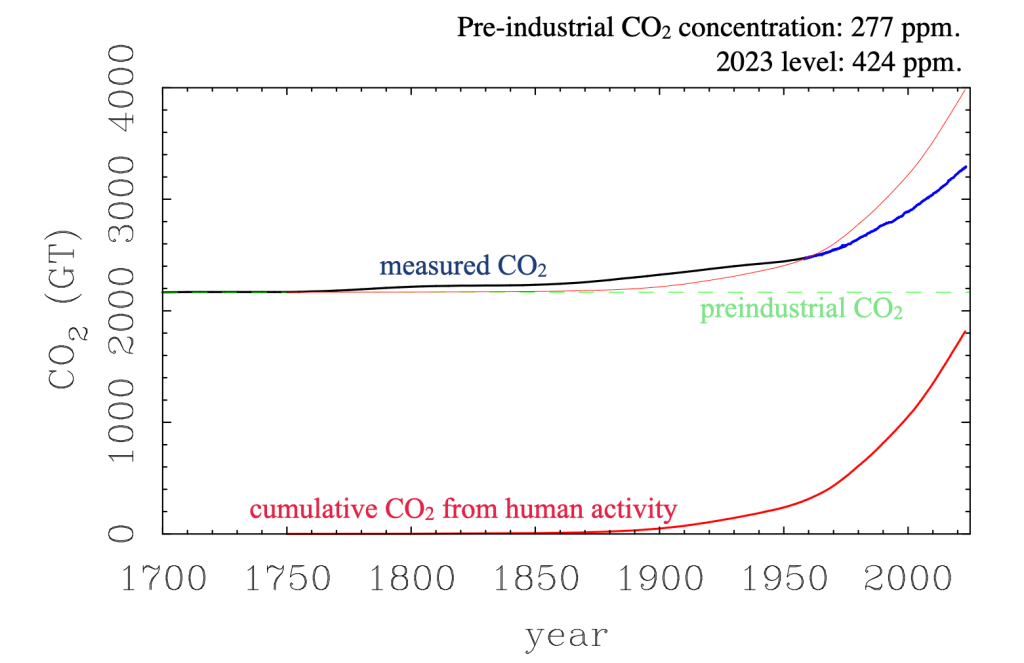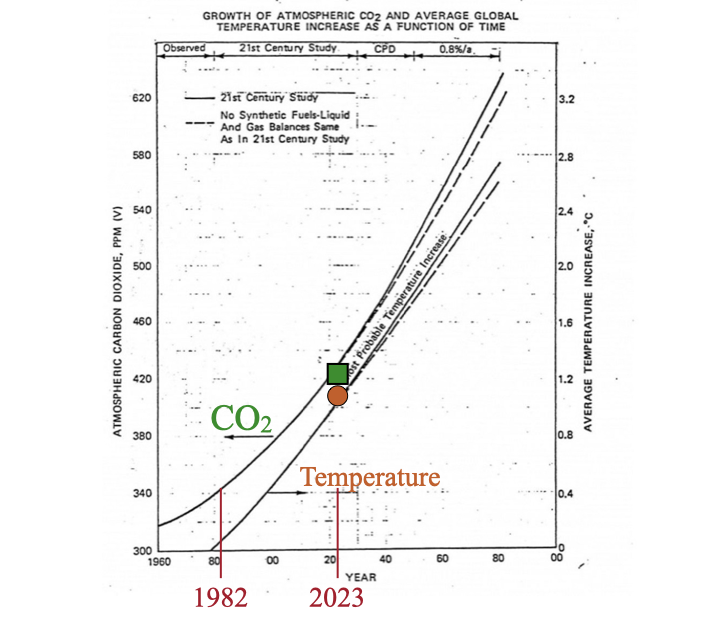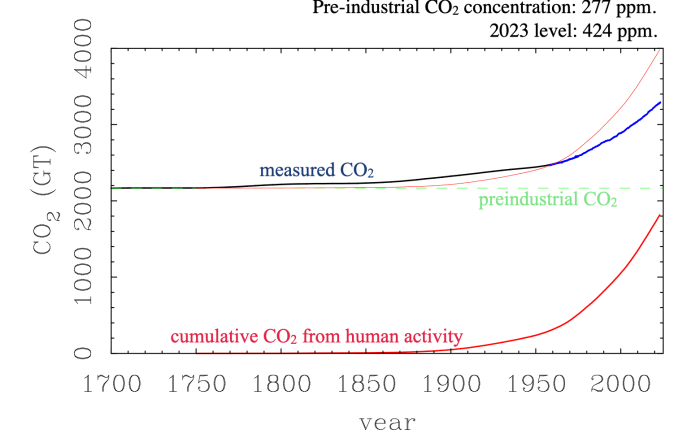Last time, I expressed extreme disappointment that fossil fuel executives had any role in leading the climate meeting COP28. This is a classic example of putting the the fox in charge of the hen house. The issue is easily summed up:
It’s difficult to get a man to understand something when his salary depends on not understanding it.
Upton Sinclair
Setting aside economic self-interest and other human foibles, it is clear from the comments that the science is not as clear to everyone as it is to me. That’s fair; I’ve followed this subject for half a lifetime, and it is closely related to my own field.
Stars are fusion reactors surrounded by big balls of gas; understanding how they work was a major triumph of 20th century astrophysics. We understand these things. Planetary atmospheres are also balls of gas; there is some rich physics there but the problem is in many ways simpler when they aren’t acting as the container for a giant fusion reactor. We understand these things. The atmospheres of Venus and Mars come up when teaching Astronomy 101, these planets represent opposite extremes of climate change run amok. From that perspective, Earth is a nice problem to have. We understand these things.
It is easy to get distracted by irrelevant details. No climate model is ever perfect, but that doesn’t mean we don’t understand what’s going on. The issue is basic physics, which has been understood for well over a century. Not only is the physics incredibly clear; so too is the need to take collective action to ameliorate the effects of climate change. The latter has itself been clear since 1990+ at least.
The temperature of a planet is the balance between heating by the sun during the day and re-radiation of that heat at night. The effectiveness of both depend on the properties of the planet. What is the albedo? That is, how much of the incident radiation is reflected into space without heating? Once heated, how efficiently can the heated surface cool by radiating energy to space?
If a planet has no atmosphere, it is a straightforward calculation to find the balance point. If the Earth had no atmosphere, the average temperature would be much colder than it is, about -18 C. Thankfully, we have an atmosphere. There is a natural greenhouse effect – nothing to do with human activity – that makes the actual average temperature more like +15 C. I, for one, am grateful for this. It also means that changing the composition of the atmosphere will change the balance point.
The bulk of Earth’s atmosphere is nitrogen and oxygen. These gases are transparent to the incoming optical radiation from the sun that heats the surface. They are also transparent to the outgoing infrared radiation that cools the surface. Despite composing the bulk of the atmosphere, they play basically zero role in the greenhouse effect. As far as climate goes, having only these gases in the atmosphere returns the same answer as the zero atmosphere case.
The natural greenhouse effect is entirely due to trace gases like water vapor and carbon dioxide. I note this because one reasonable-sounding falsehood that gets repeated a lot is that CO2 is a trace gas, so it can’t possibly make a difference. That’s like saying adding a small dash of poison to a beverage isn’t dangerous. Or that it makes no difference to draw a shade over a window. The shade may be much thinner than the glass of the window, but unlike the transparent glass, the shade is opaque. That’s the property greenhouse gases provide, even in trace quantities: they are opaque to the infrared radiation that is trying to cool the surface by escaping to space.
If we looked down on the Earth with eyes that saw in the infrared part of the spectrum where greenhouse gases trap heat, we’d wouldn’t see the surface of the planet. Instead, we’d see a hazy ball: the effective altitude in the atmosphere from which infrared radiation can escape to space. This isn’t a solid surface any more than the edge of a cloud is – to you and me. To the photons seeking escape, it is an effective barrier. Some don’t make it out.
The greenhouse gases are like a fog bank that has to be traversed before the heat carried by the infrared radiation can escape into space. If we add greenhouse gases to the atmosphere, it makes the fog bank thicker, effectively trapping more heat. At a basic level, the issue is that simple. The science is entirely settled; no one seriously* debates this. It has been known for over a century.

The leading greenhouse gas in Earth’s atmosphere is water vapor. You don’t need a fancy scientific instrument to detect this effect, just your own senses. High humidity leads to hot, sultry nights while low humidity allows rapid cooling. To feel this, visit a humid place like New Orleans and an arid one like the desert of the US west. These places feel very different at night even when their daytime temperatures are similar. The humid place cannot cool effectively because of the greenhouse effect provided by water vapor, and nighttime temperatures can remain unpleasantly high. In the dry desert, the temperature drops like a rock as soon as the sun sets, and it can get rather chilly even if it was baking hot all day long. I’ve personally experienced both conditions many times; the difference is stark and obvious.
The amount of water vapor the atmosphere can hold is a function of temperature, but on bulk it is always less than half a percent. That trace gas is nevertheless 100% of what you care about in the morning weather forecast, as it leads to rain, snow, sleet, hail, cloud cover, and all the other weather phenomena that makes life near the triple point of water interesting. Indeed, clouds increase the albedo of the planet, reflecting some of the incoming solar radiation, so water in the atmosphere prevents some heating as well as helping to retain warmth once heated. This is pretty much in balance, as the limit on how much water vapor the atmosphere can hold means that equilibrium is achieved on a short time scale: too much humidity, and it rains. The sources and sinks of H2O in the atmosphere balance out on short timescales readily perceptible to humans. It’s what we call weather.
The next most important greenhouse gas is CO2. That too has a natural level with sources and sinks. The issue that induces human-caused climate change is the extra CO2 we put in the atmosphere by burning coal, oil, etc. for the energy it provides. This does not balance out on a short timescale, so there is a cumulative effect on the climate, as anticipated in 1912.
Producing energy is a good thing; no one here is advocating that we stop doing this add return to living like cavemen. Heck, even cavemen had an environmental impact: they burned enough wood to blacken many a cave roof. Human activity has always left a mark; the problem today is that there are 8+ billion of us doing a lot more than making campfires. That adds up to a measurable change in the composition of the atmosphere.
The natural pre-industrial level of CO2 was about 277 parts per million (ppm). Here is a graph of the CO2 content of the atmosphere over the past few centuries, extending to back before the onset of the industrial revolution when our collective experiment in atmospheric physics got going. We know how much carbon we’ve burned (that’s economic activity with profits and receipts, we know this number quite well) and we can measure how much CO2 is in the atmosphere directly. They ramp up together.

There is lots that can be said about this plot. Just some basic points: the amount of CO2 in the atmosphere has gone up as we have burned coal and oil to generate energy. We have measurably changed the composition of the atmosphere we all breathe. The current CO2 content of the atmosphere is 424 ppm, which is much larger than the pre-industrial level of 277 ppm. That by itself ought to give one pause: we are conducting an uncontrolled experiment in atmospheric physics on a global scale. That seems like a bad idea, even if we didn’t understand heat propagation in the atmosphere, which we do.
Not only has the amount of CO2 in the atmosphere increased as we’ve burned things, it is accumulating. There are natural sinks, which is why the extra amount of CO2 in the atmosphere is less than what we’ve added: not all of it sticks around. Much of it has been absorbed by the ocean, which is acidifying as a result. But lots of CO2 persists in the atmosphere: the timescale for it to “rain out” is much longer than for water. It will take many decades and probably centuries to restore anything resembling equilibrium. We aren’t just adding CO2 to the atmosphere, we’re making a long-term investment in having it there. Future generations will have to contend with the consequences of what we’ve already done.
What have we already done? I’ve outlined the basic physics; let’s now check the predictions of one of the earliest forecasts. This is from a 1982 report generated by Exxon scientists:

The study made over forty years ago accurately forecast where we are today. These predictions have repeatedly been corroborated. Some models may miss minor details here and there, but the basic picture is crystal clear. Anyone who tells you otherwise has some fossil fuels to sell.
Enough has been written on this subject; I won’t suggest solutions nor delve into likely impacts. But there is absolutely no doubt that climate change is real and that we caused it. None. That this simple, plain fact is not obvious to everyone at this point is a credit to the power of disinformation and propaganda. The best course forward from here is debatable. Pretending like it isn’t a problem is straight-up reality denial.
+It has become a trope of wingnut politics in the U.S. that scientists only say climate change is real so they can get research grants. That’s ridiculous on many levels. One reason that such grants exist is that right wing politicians asked for more research. This was a delaying tactic employed in the early 1990s by then-president and oil magnate George H. W. Bush.
Fresh off the success of regulatory repair to the ozone hole problem in the late 1980s, it was reasonable to hope that we could start tackling the threat of climate change. This was a much bigger problem encompassing a broader range of human activity, but the basic science is far simpler than the atmospheric chemistry that threatened ozone. Industries that didn’t want to be regulated whined about that as usual, but no one seriously questioned the science. After the usual wailing and gnashing of teeth, appropriate regulatory action was taken, and it worked.
When it came to doing the same thing with the oil industry when an oil baron was president, well, harrumph harrumph, more research was needed. The first Bush was a Republican, but he wasn’t a backwards science-denying goon, so he offered to fund more research. It was an obvious delaying tactic, but the argument in favor of it was to make the case more convincing. So the science community was like, sure, the basic answer is already clear, but there are things that we could understand better, so we’ll do more research if that helps you to also understand the problem. But it hasn’t helped people who don’t want to understand to do so, and never will, because the problem is with them, not with the science. So now, thirty years on from Bush I, the same political party that demanded more research be done now routinely attacks scientists for doing the research they asked scientists to do.
Sorry, not sorry: just because you don’t like the answer science gives doesn’t make it wrong. It is well past time for climate denying snowflakes to stop having emotional meltdowns and grow up already.
*Sometimes it is asserted that the opacity of CO2 is already saturated, so adding more doesn’t matter. Yes on one, no on two. Even at saturation we can still make the fog bank thicker by adding more CO2 – just ask Venus. Indeed, we’re dang lucky that the CO2 bands are already saturated; if not for that, the response of the climate to adding as much CO2 as we have would be much stronger. If these features were not saturated the response would be linear instead of incremental, so the temperature would have already increased by about an extra 7 C, not the mere 1 C we’ve so far** accomplished.
**Just how much we’ve added depends on how you define “before.” Modern studies often seem to adopt the average temperature measured between 1980 and 2000, presumably because the data with which to do so are very good. This gives an increase since then around 1.1 C, which is a remarkable amount of growth in just a few decades: we’ve tipped the climate system out of anything resembling equilibrium hard and fast. Of course, the impact of human activity was already palpable before 1980, so the total change since the industrial revolution is closer to 1.5 C. We’re not quite to that arbitrary threshold yet, but I see no way to avoid blowing past it. Talk of doing so is predicated on giving us a half degree mulligan by defining “average” during a period that is not average. So if you think portrayals of the problem are exaggerated, it is actually already worse than generally depicted.


